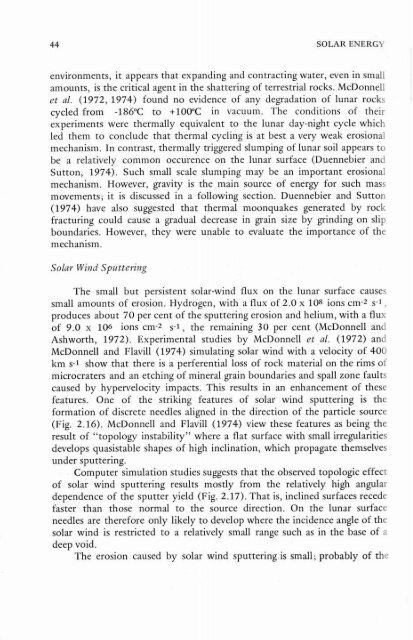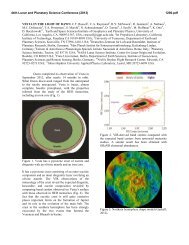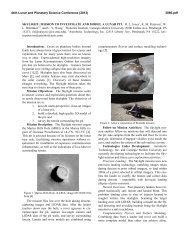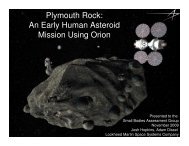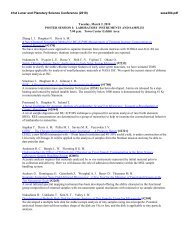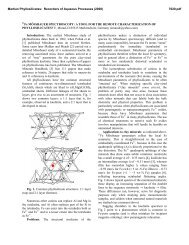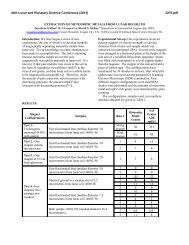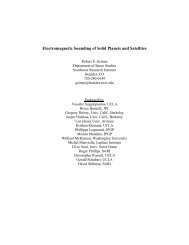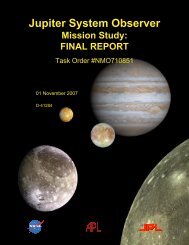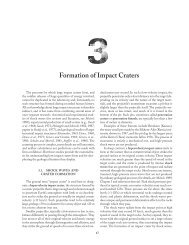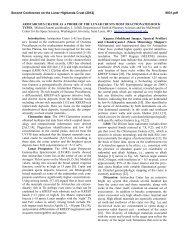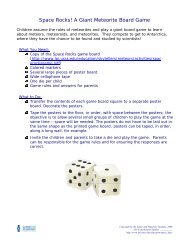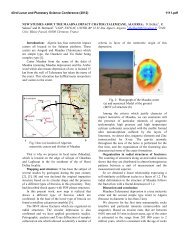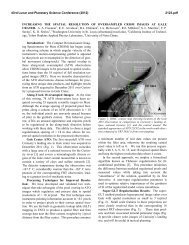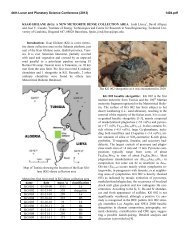Chapter 2: Energy at the Lunar Surface - Lunar and Planetary Institute
Chapter 2: Energy at the Lunar Surface - Lunar and Planetary Institute
Chapter 2: Energy at the Lunar Surface - Lunar and Planetary Institute
You also want an ePaper? Increase the reach of your titles
YUMPU automatically turns print PDFs into web optimized ePapers that Google loves.
44 SOLAR ENERGY<br />
environments, it appears th<strong>at</strong> exp<strong>and</strong>ing <strong>and</strong> contracting w<strong>at</strong>er, even in small<br />
amounts, is <strong>the</strong> critical agent in <strong>the</strong> sh<strong>at</strong>tering of terrestrial rocks. McDonnell<br />
et al. (1972, 1974) found no evidence of any degrad<strong>at</strong>ion of lunar rocks<br />
cycled from -186°C to +lOO°C in vacuum. The conditions of <strong>the</strong>ir<br />
experiments were <strong>the</strong>rmally equivalent to <strong>the</strong> lunar day-night cycle which<br />
led <strong>the</strong>m to conclude th<strong>at</strong> <strong>the</strong>rmal cycling is <strong>at</strong> best a very weak erosional<br />
mechanism. In contrast, <strong>the</strong>rmally triggered slumping of lunar soil appears to<br />
be a rel<strong>at</strong>ively common occurence on <strong>the</strong> lunar surface (Duennebier <strong>and</strong><br />
Sutton, 1974). Such small scale slumping may be an important erosional<br />
mechanism. However, gravity is <strong>the</strong> main source of energy for such mass<br />
movements; it is discussed in a following section. Duennebier <strong>and</strong> Sutton<br />
(1974) have also svggested th<strong>at</strong> <strong>the</strong>rmal moonquakes gener<strong>at</strong>ed by rock<br />
fracturing could cause a gradual decrease in grain size by grinding on slip<br />
boundaries. However, <strong>the</strong>y were unable to evalu<strong>at</strong>e <strong>the</strong> importance of <strong>the</strong><br />
mechanism.<br />
Solar Wind Sputtering<br />
The small but persistent solar-wind flux on <strong>the</strong> lunar surface causes<br />
small amounts. of erosion. Hydrogen, with a flux of 2.0 x 10s ions cm-2 s-1,<br />
produces about 70 per cent of <strong>the</strong> sputtering erosion <strong>and</strong> helium, with a flux<br />
of 9.0 x 106 ions cm-2 s-1 , <strong>the</strong> remaining 30 per cent (McDonnell <strong>and</strong><br />
Ashworth, 1972). Experimental studies by McDonnell et al. (1972) <strong>and</strong><br />
McDonnell <strong>and</strong> Flavill (1974) simul<strong>at</strong>ing solar wind with a velocity of 400<br />
km s-1 show th<strong>at</strong> <strong>the</strong>re is a perferential loss of rock m<strong>at</strong>erial on <strong>the</strong> rims of<br />
microcr<strong>at</strong>ers <strong>and</strong> an etching of mineral grain boundaries <strong>and</strong> spa11 zone faults<br />
caused by hypervelocity impacts. This results in an enhancement of <strong>the</strong>se<br />
fe<strong>at</strong>ures. One of <strong>the</strong> striking fe<strong>at</strong>ures of solar wind sputtering is <strong>the</strong><br />
form<strong>at</strong>ion of discrete needles aligned in <strong>the</strong> direction of <strong>the</strong> particle source<br />
(Fig. 2.16). McDonnell <strong>and</strong> Flavill ( 1974) view <strong>the</strong>se fe<strong>at</strong>ures as being <strong>the</strong><br />
result of "topology instability" where a fl<strong>at</strong> surface with small irregularities<br />
develops quasistable shapes of high inclin<strong>at</strong>ion, which propag<strong>at</strong>e <strong>the</strong>mselves<br />
under sputtering.<br />
Computer simul<strong>at</strong>ion studies suggests th<strong>at</strong> <strong>the</strong> observed topologic effect<br />
of solar wind sputtering results mostly from <strong>the</strong> rel<strong>at</strong>ively high angular<br />
dependence of <strong>the</strong> sputter yield (Fig. 2.17). Th<strong>at</strong> is, inclined surfaces recede<br />
faster than those normal to <strong>the</strong> source direction. On <strong>the</strong> lunar surface<br />
needles are <strong>the</strong>refore only likely to develop where <strong>the</strong> incidence angle of <strong>the</strong><br />
solar wind is restricted to a rel<strong>at</strong>ively small range such as in <strong>the</strong> base of a<br />
deep void.<br />
The erosion caused by solar wind sputteringis small; probably of <strong>the</strong>


